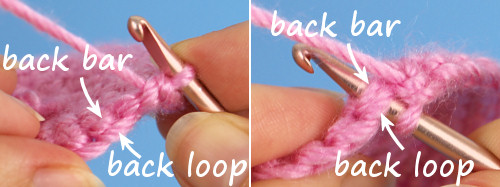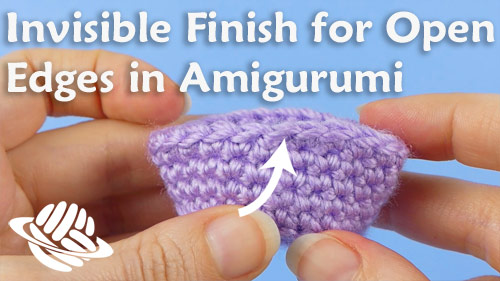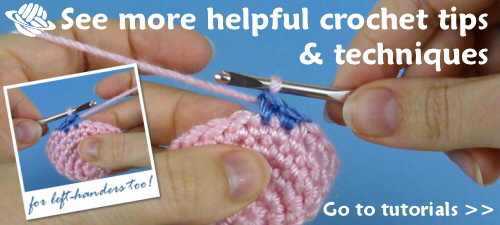Invisible Finish for Open Edges in Amigurumi
The standard way to finish an open-ended piece in amigurumi is to join with a slip stitch (sl st) to the next stitch, to reduce the height jog of the spiral between the first and last stitches of the final round. It’s a quick and easy method, and is perfectly fine if you’ll be stitching the piece down to something else so the edge won’t show in the finished amigurumi.
That’s not always the case, though – sometimes the edge will be visible in the finished piece, and in this case the sl st finish isn’t the best choice – it leaves a little bump that’s impossible to hide completely.
I highly recommend you always use an Invisible Finish instead if the join will be visible in your finished piece – it doesn’t leave a bump, and makes a much smoother, neater join.
(If you’d like to see how I came up with this technique, see my Invisible Finish Investigation, where I analysed multiple options to determine which gives the best-looking finish.)
You can see the technique in action (with my refinement that makes it much easier to control the size of the duplicate stitch and keep it held in place once you’ve adjusted it to the right size) in the videos below:
Video Tutorial (right-handed)
Video Tutorial (left-handed)
Note: The videos may look a little small embedded in the blog: if so, you can fullscreen them or click through to YouTube (links: right-handed; left-handed) to watch them full-sized 🙂
Text Instructions
Quick terminology lesson in case you can’t watch the video and want to follow the text instructions below instead:
When you look at a single crochet stitch, you usually work into both the front loop and the back loop at the top of the stitch:

But, if you rotate your work forwards a bit, you can see that there’s another horizontal bar just beneath the back loop, at the back of the stitch (below, left).
In step 4 below, you’ll insert the needle into both the back loop and this back bar (replace the hook in the pic below, right, with your yarn needle!)

To make an Invisible Finish:
- Complete your last stitch and then cut the yarn leaving a 6″/15cm tail.
- Pull on the loop on your hook to draw the cut yarn tail up to the top, then thread the yarn tail onto a yarn needle.
- Skip the next unworked stitch, and insert your needle, going from front to back, under both bars of the following stitch. Draw the yarn through to the back.
- Go back to your final stitch (that has the yarn tail emerging from the middle of it). Insert your needle down into this stitch so it passes under both the back loop of the stitch and the back bar behind that loop.
- Pull the yarn through, then pull on the yarn tail to draw the loop smaller until it matches the size of all the Vs around the top edge of your piece.
- Use the yarn needle to weave the yarn tail through the backs of several stitches, to help lock the duplicate stitch loop in place, then trim the remaining yarn tail.

As you can see, the Invisible Finish completes a continuous row of Vs around the edge of the piece, while also bridging the height gap between the first and last stitches of the round.
It’s an essential technique if you want a perfect finish for your open-edged pieces!
Loved this tutorial? I have so many more amigurumi tips and tricks to share with you!
Boost your amigurumi skills with my latest book, The Essential Guide to Amigurumi, your comprehensive guide to amigurumi techniques and tips.
Do you find my tutorials helpful? If so, please consider making a contribution towards my time so I can continue to create clear and concise tutorials for you:
Thank you so much for your support! Now click below for loads more crochet video and photo tutorials (and do let me know what else you’d like me to cover in future tutorials…)


















Gladys said
Hi June, Thank you so much for all your videoes. They have made such a big difference in my work! Have you tried making a slip stitch before you finish off in order to decrease the height of the last stitch?? It’s not such a big jump and the ending is less noticeable. Thank you again for your videos they are wonderful!!
June said
You’re welcome, Gladys! I always try to recommend the best version of any technique I demonstrate, and in this case I tried it both ways (with and without a slip stitch preceding the join) before I decided on my recommended method.
Because of the way a slip stitch works, even though it reduces the height of the jump your duplicate stitch covers, it also reduces the invisibility of the finish for a couple of reasons:
For those reasons, I decided I prefer the cleaner look without the visible glitches caused by adding the slip stitch, hence my recommendation. (But, of course, it’s up to you which you prefer – there’s no ‘right’ or ‘wrong’ answer in crochet!)
Martha said
Excellent video. since most of the crochet I do is not amigurumi – this finishing touch will be very useful as the last stitches are in plain view..
Alaia said
Thanks for your excellent videos!!!!